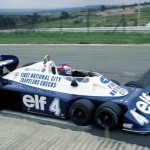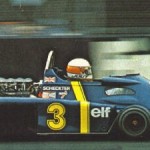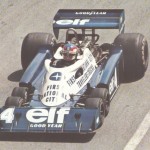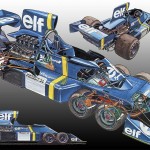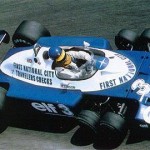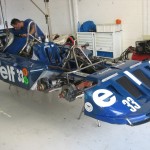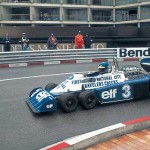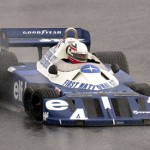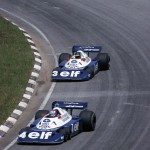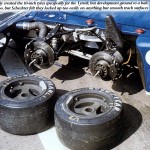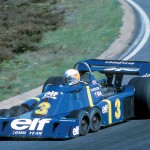Fever machines: Tyrrell P34 ‘six-wheeler’
 Everyone has a shortlist of favourite competition cars – evocative machines that capture the imagination, stir the soul or bring back certain memories. Is it the way they look or the way they go? Invariably, it’s a combination of the two – obvious candidates include Maserati’s 250F, Porsche’s 917 or Lancia’s Stratos, to chose three iconic weapons (and personal favourites) from Formula 1, sportscar racing and rallying respectively.
Everyone has a shortlist of favourite competition cars – evocative machines that capture the imagination, stir the soul or bring back certain memories. Is it the way they look or the way they go? Invariably, it’s a combination of the two – obvious candidates include Maserati’s 250F, Porsche’s 917 or Lancia’s Stratos, to chose three iconic weapons (and personal favourites) from Formula 1, sportscar racing and rallying respectively.
For some, however, favourites can be oddballs, creations whose designers thought outside the box, or pushed the regulation envelope. Unsuccessful and/or unattractive (to others) doesn’t matter: quirkiness can be a popular problem to have.
For me, a car that gets the memory juices flowing every time I see it is the extraordinary Tyrrell P34 – the only six-wheeled car to win a world championship grand prix. Aged just five when it appeared, in the 1976 Spanish GP at Jarama, I recall questioning why the de rigueur, one-wheel-in-each-corner set-up had been overlooked by this great British team. Needless to say, it was years before I properly understood. Didn’t stop me loving it – and cherishing the Corgi diecast model now in my four-year-old’s collection.
 Brainchild of Derek Gardner, who had designed world title-winning Elf-blue Tyrrells for Ken’s eponymous team, the P34 caught the imagination like no racing car before or, for me, since.
Brainchild of Derek Gardner, who had designed world title-winning Elf-blue Tyrrells for Ken’s eponymous team, the P34 caught the imagination like no racing car before or, for me, since.
Gardner, who had first mapped out a six-wheel layout in his head while trying to get the four-wheel-drive Lotus Indycar to handle properly in the late 1960s, persuaded Ken Tyrrell that, in order to boost the team’s flagging fortunes with its ageing 007, his next F1 contender should really push the boat out. With the 3-litre Ford Cosworth DFV V8 as most teams’ engine of choice, along with standard-spec Hewland gearboxes and Goodyear tyres to harness that off-the-shelf power supply, it needed innovative thinking to stay ahead of the game. The P34 would represent Tyrrell’s unique approach.
Gardner presented his idea for a six-wheeled car to Ken Tyrrell in the second half of 1974, explaining his thinking for the radical design. Gardner reasoned that standard-sized, exposed front tyres caused excessive lift. Make them smaller and you eliminate the problem. To combat the reduced contact patch due to the smaller tyres, the design genius added another pair of wheels. Without a huge wing – required to generate downforce on a car with standard-sized wheels – the concept car would, in theory, enjoy a straightline speed advantage thanks to less drag.
Having got over his initial shock at the oddball design, Tyrrell gave the project his personal blessing. A prototype was readied in secrecy in the team’s Surrey workshop – it was a 007 with a ‘new’ front – and, over a year after the initial drawing had been presented to Tyrrell, the amazing machine was rolled out for testing at Silverstone.
 Problems from the outset, particularly with the 10-inch tyres coming off the rims through over-stressing, meant that the car was not ready for its maiden grand prix appearance at the start of 1976. That debut would come in round four, the Spanish GP at Jarama, when a single P34 was entered for Frenchman Patrick Depailler. There was much about which to be encouraged after Depailler qualified third and raced strongly in that position until brake failure intervened. It was a strong start for the P34 and, for the rest of the season, Depailler and his team-mate Jody Scheckter would each have a six-wheeler at their disposal.
Problems from the outset, particularly with the 10-inch tyres coming off the rims through over-stressing, meant that the car was not ready for its maiden grand prix appearance at the start of 1976. That debut would come in round four, the Spanish GP at Jarama, when a single P34 was entered for Frenchman Patrick Depailler. There was much about which to be encouraged after Depailler qualified third and raced strongly in that position until brake failure intervened. It was a strong start for the P34 and, for the rest of the season, Depailler and his team-mate Jody Scheckter would each have a six-wheeler at their disposal.
The P34’s first and only GP win came at Anderstorp in Sweden that June. Although Depailler led home Scheckter for a one-two finish, it proved to be a false dawn. The car lagged behind its rivals McLaren and Ferrari on the development front, especially when it came to those pesky 10-inch tyres. Goodyear focused on its monopoly on standard front and rear tyres, creating a feeling that the special fronts used on the P34 had become the poor relation.
For 1977, Scheckter moved to Canadian oil magnate Walter Wolf’s new outfit, leaving a vacancy at Tyrrell for super Swede Ronnie Peterson. Could the former world championship runner-up, who’d won races for Lotus and March, pull the P34 further up the grid? Sadly not – four podium finishes, none of them the top step – was the best the by-now prehistoric machine could muster.
A third place for Depailler in the 1977 finale at Fuji marked the end of the six-wheel dream. In two short seasons, the Tyrrell P34 had captured the imagination and, at times, caused mirth and merriment up and down the pitlane. Despite that, and a lifespan of just 30 grands prix, the car had well and truly booked itself a place in the hall of fame.
Check out Project34 for a very detailed look at the P34

